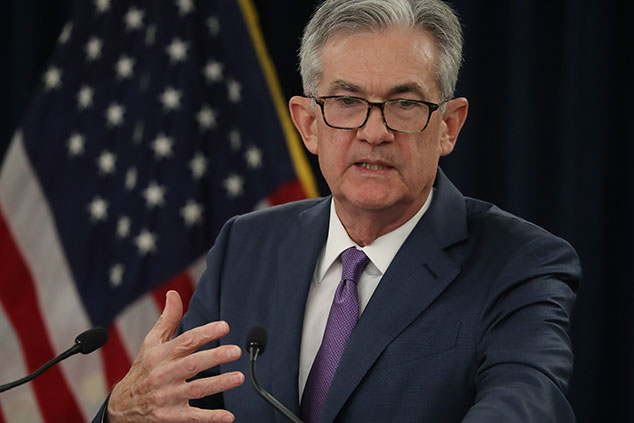
This article is taken from our FREE daily investment email Money Morning.
Every day, MoneyWeek’s executive editor John Stepek and guest contributors explain how current economic and political developments are affecting the markets and your wealth, and give you pointers on how you can profit.
Yesterday, the Federal Reserve, America’s central bank, cut interest rates by 0.25%. This was the first such cut since 2008.
That sounds pretty scary. And it’s fair to say that the market didn’t like it.
But not because investors are now worried about recession. It’s because the Fed sounded far too upbeat about the economy even as it made the cut.
How the Fed accidentally tightened monetary conditions
Stockmarkets normally like it when the Federal Reserve cuts interest rates. That wasn’t the case yesterday.
Why not? Because even though the economy really isn’t that bad (full employment, mild inflation and solid if not outstanding growth are not generally viewed as “bad things”, economically-speaking), the Fed was expected to cut a lot more aggressively.
Markets have worked themselves into such a lather that anything less than a half-point cut was bound to disappoint. And Fed chairman Jerome Powell also needs lessons from Mario Draghi in managing expectations.
Powell described the cut as a “mid-cycle adjustment”, and noted that it was “not the beginning of a long series of rate cuts”. Markets didn’t like that, because they had been betting on rates being pretty much a full percentage point lower by this time next year.
In effect, by cutting less than markets expected, Powell in fact tightened monetary policy. Markets now expect fewer rate cuts. As a result, the US dollar strengthened. The yield curve deteriorated (investors are betting on a recession, or at least a close-run thing). And stocks fell.
Is this what Powell intended? I suspect not.
As Helen Thomas of Blonde Money points out, the problem here is that the Fed is cutting rates for no obvious reason, and so its communication is lagging behind its intent. In other words, they haven’t yet got their excuses straight.
That, she reckons, will be rectified in the next few days by one or other of the more dovish “brains” behind the Fed chair coming out and soothing markets that this isn’t just “one and done” (as Powell himself rushed to reiterate).
It’s also worth noting that quantitative tightening (QT – the process by which the Fed reverses quantitative easing) was stopped altogether yesterday. It has been scheduled to continue for another two months. This appears not to have been widely commented on, but it’s certainly not hawkish.
The biggest worry here, as always, is the US dollar. It’s currently rather strong, and that’s not what Donald Trump wants. It’s hard to win a trade war when your efforts to drive up prices of imports by imposing tariffs are being rendered irrelevant by the sliding value of the currency in which those imports are priced.
Moreover, an expensive dollar makes life harder for S&P 500 companies. A significant chunk of their earnings are made overseas. An earnings squeeze wouldn’t bode well for an arguably overvalued stockmarket.
The risk is that the Fed takes so long to get its excuses in line that the European Central Bank manages to overtake it in the currency-trashing, recession fear, and loose monetary policy stakes. But we’ll just have to wait and see.
Meantime, stick to your investment plan. It’s useful to be on top of all of this central bank stuff as it’s one of the main man-made factors that pushes the markets around. Knowing what’s happening can help you to avoid panic.
But on a day-to-day basis, what matters most is having a plan in the first place, understanding roughly what you need to save to achieve your goals and then actually saving that amount every month (or quarter), and then controlling your cost of investment so that your hard-earned cash doesn’t mostly line the industry’s pockets.
As with most of the important things you need for a good life, it’s simple, but not easy.
A quick reminder – book your ticket now before the prices go up
We’ll also be discussing how to cope with all this monetary madness at the MoneyWeek Wealth Summit in London on 22 November.
Indeed, we’ll be talking about all of the big issues of the day and how they could affect your investments – from the impact of whatever type of Brexit we may or may not have achieved by that point; to the chances of a hard-left government taking power in the UK or the US; to the likely direction of monetary policy, as we head into apparently uncharted territory.
Our speakers include Russell Napier, the hugely-respected author of a bona fide financial classic, Anatomy of the Bear (which you can buy here). He’s a renowned investment analyst and economic historian. His perspective is invaluable when it comes to looking at unexpected events that could upturn the apple cart.
We’ve also got British entrepreneur and investor Jim Mellon, who’ll be talking about the hugely exciting investment area that he’s currently spending most of his time investigating and backing. It could be transformational for all of us and not just in terms of wealth – indeed, that could be the least of it.
It promises to be a great day, with some of the most stimulating conversation and investment ideas you’ll hear anywhere this year. Merryn and I would both like to see you there, so book your place now to make sure you don’t miss it.
And if you need another reason to act right now, then here you go – you can still get the tickets at a knock-down price. But the early bird discount ends at midnight on Monday 5 August. After that, prices go up. So don’t leave it until the last minute – book your place now to make sure